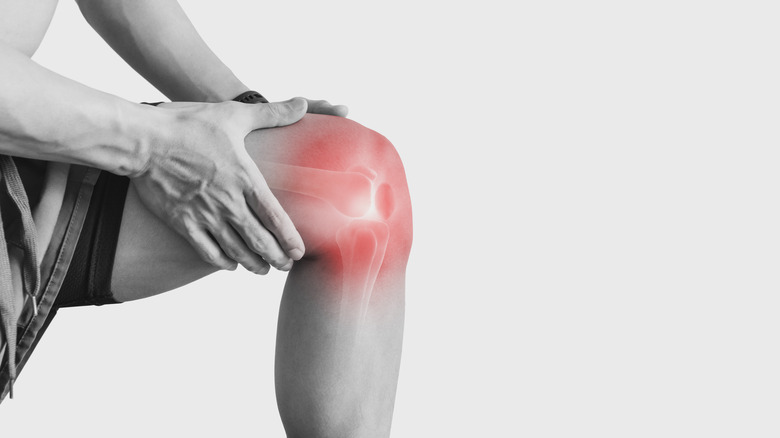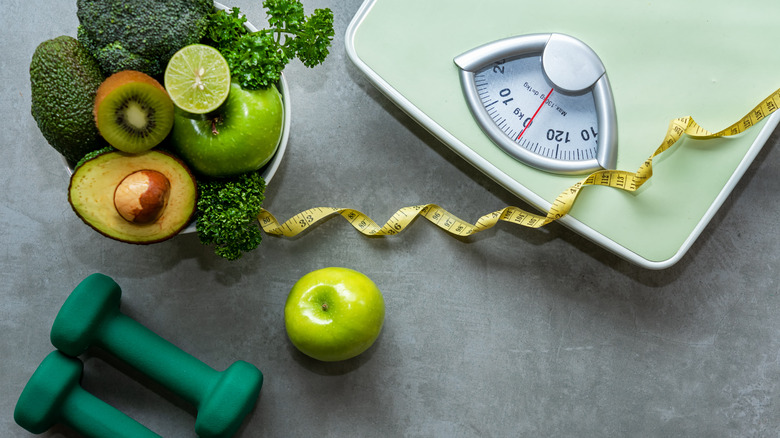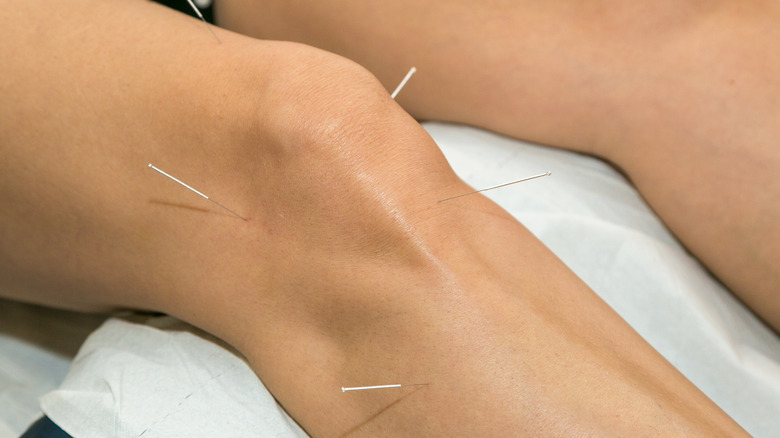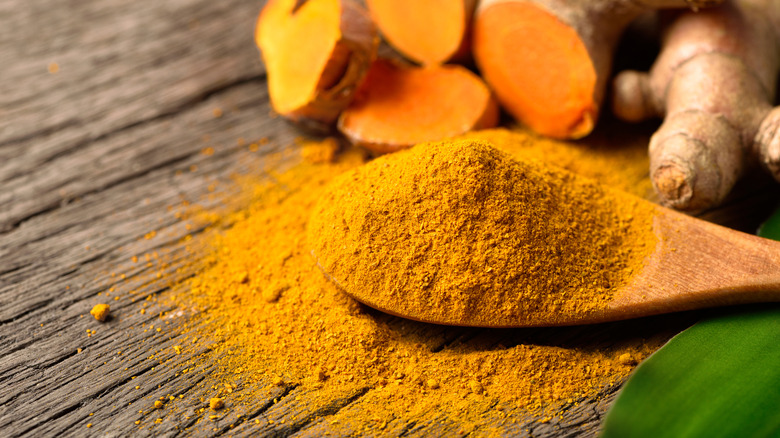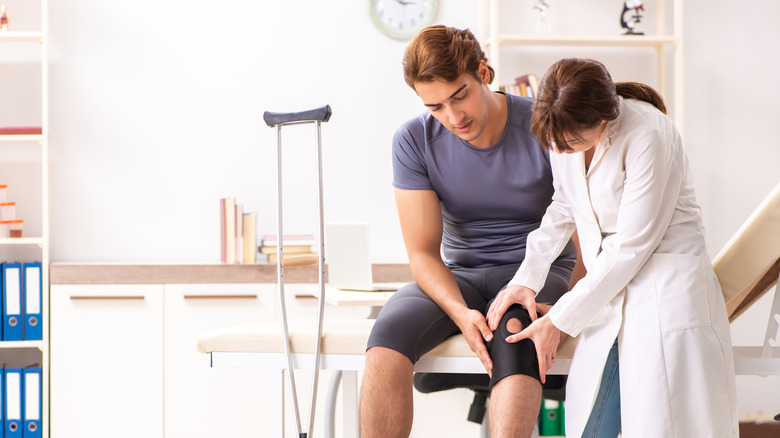What You Should Be Doing To Manage Arthritis Pain
Arthritis is a condition that affects the joints, causing pain, inflammation, and stiffness. Some people with arthritis have trouble moving their joints over time, long considered a classic symptom. However, various forms of arthritis behave differently in the body and can affect the type and severity of symptoms. In fact, the Arthritis Foundation states that there are more than 100 kinds of arthritis and related conditions.
Osteoarthritis and rheumatoid arthritis are the two primary types of this condition. Osteoarthritis breaks down the cartilage that cushions joints, while rheumatoid arthritis causes the immune system to damage the joints directly. Other kinds include gout, septic arthritis, and ankylosing spondylitis (via Mayo Clinic).
As for where it comes from, arthritis can stem from genetics, lifestyle, autoimmune diseases, infections, or exacerbated wear and tear on the joints (via Cleveland Clinic). Once it hits and starts damaging joints, arthritis can cause mild to severe pain that can be difficult to manage. Thankfully, making some lifestyle changes and understanding therapeutic strategies can lead to better pain management for this type of inflammation.
Fight inflammation through diet
A significant cause of the pain associated with arthritis is inflammation surrounding the joints. That pain often arrives as the immune system fights against whatever it deems to be an issue. In the case of arthritis, that's the joints.
Therefore, reducing the inflammation response in the body is a potentially good idea for people with arthritis. The Arthritis Foundation notes that the Mediterranean diet — one that's filled with whole foods and low in processed stuff and "bad" fats — is one of the best for combating arthritic pain. The diet incorporates fish, nuts, seeds, healthy oils, and plenty of fresh fruits and vegetables. These categories include several anti-inflammatory foods that help to keep that symptom at bay.
The Harvard T.H. Chan School of Public Health also explains the importance of an anti-inflammatory diet, especially in those with chronic inflammation. Rather than focus on calories and portions, an anti-inflammatory diet focuses only on the foods you eat and don't eat. Tea, coffee, herbs, whole grains, and monounsaturated fats get the green light, for instance. But those following this diet must typically stay away from sweetened drinks, fried foods, and processed meats.
Take inflammation-reducing medication as needed
Not all pain from arthritis can be managed by a healthy diet alone, unfortunately. People with severe arthritis symptoms might still need to take pain-reducing medications to keep them moving and able to function daily.
Corticosteroids are one form of medication commonly prescribed for arthritis. They target pain by reducing inflammation and are generally available in cream, pill, or shot form. Some arthritis patients may respond better to nonsteroidal anti-inflammatory drugs (NSAIDs), which include many of the typical pain relief medications you'll find in the pharmacy. Ibuprofen, naproxen, and aspirin are forms of NSAIDs, for example. These also decrease inflammation and can work relatively quickly for those seeking immediate relief (via Verywell Health).
Some people with persistent or severe arthritis may need high doses of NSAIDs that can only be prescribed by a doctor to manage their pain. Your doctor can use different doses and medicating schedules to find one that works best for your symptoms and body (via Arthritis Foundation).
Supplements might help to reduce inflammation
Medication may not work well for everyone, and indeed some people may wish to try more natural routes before going with prescription medications. As such, a number of supplements have been shown to reduce arthritic symptoms, including pain, by reducing inflammation and even potentially by building cartilage. They could be worth a try, though it's always a good idea to talk to your doctor first before starting a supplement regimen.
The Arthritis Foundation lists vitamins A, C, E, D, and K as vital nutrients which also contain antioxidants and may aid in reducing arthritis symptoms, although researchers are still studying their efficacy related to arthritis. However, we do know that vitamins D and K both strengthen bones, while vitamin K is necessary for cartilage health. Glucosamine and chondroitin also have some mixed results in studies, but researchers have shown that joint cartilage contains these compounds. Some evidence has shown that these two could improve arthritis pain, especially when combined with NSAID treatment.
EPA and DHA, two omega-3 fatty acids found in fish and fish oil supplements, also have anti-inflammatory properties. An article published in the journal Atherosclerosis outlined the results of a study where participants with chronic inflammation used EPA and DHA supplements for 10 weeks. Researchers found that both fatty acids appeared to reduce inflammation, with DHA leading to slightly better results.
Pay attention to the numbers on the scale
Extra body weight, naturally enough, puts extra strain on joints. Pain management specialist and doctor Robert Bolash tells Cleveland Clinic, "Joints in your body's lower half — particularly your knees and hips — bear most of your weight. That's why years of carrying around excess weight contribute to achy, swollen, stiff joints." Bolash recommends using low-impact exercises, like swimming or water aerobics, to shed pounds without causing more pain and discomfort to joints in the process. Rheumatologist Elaine Husni also explains that losing a mere 10 pounds can sometimes be all it takes to improve knee pain related to osteoarthritis.
Not only can losing weight improve pain associated with arthritis, but it could actually improve joint function altogether. Richard F. Loeser, Jr., a rheumatologist and research leader, tells Everyday Health that a study he conducted showed that knee joint pressure improved over time with routine exercise and diet changes. Additionally, participants had decreased inflammation after losing weight, which is even more good news for the joints.
Get better sleep
It's no secret that getting plenty of shut-eye does a body good. Quality sleep can lower your risk of heart attacks, improve your mood, and keep many more of your body systems on track. Having good sleep hygiene that helps you get a full night of rest could also improve your arthritis pain. According to the Arthritis Foundation, pain from arthritis can certainly keep you up at night. However, it appears that not getting enough sleep can also trigger inflammation and pain, resulting in a cycle of sleeplessness and health consequences that's admittedly tough to break. Director of the Alabama Research Institute on Aging Patricia Parmelee explains that failing to catch enough sleep can contribute to increased pain the next day, while chronic sleeplessness may even progress one's arthritis further over time.
So, what to do if you're stuck in just such a cycle? According to Medical News Today, people with arthritis should prioritize their sleep by getting into a routine. Exercising during the day, avoiding naps, and sticking with the same bedtimes and wake-up times can be helpful. Managing stress and eating healthy, wholesome meals can also contribute to better sleep patterns and, therefore, decreased arthritis symptoms.
Keep your body active
Add one more fact to the many reasons why exercise is essential: Apparently, people with arthritis may experience decreased pain when they participate in routine exercise. The CDC states that physical activity is necessary for healthy joint function and reduced symptoms, including pain and mood. The most important thing to remember is to find exercise routines that are low-impact for your joints. The CDC also recommends starting slow with any exercise and modifying exercises as needed to keep your body comfortable.
What are the best exercises for people with arthritis? According to Medical News Today, simple stretching tops the list. Yoga is just one example of a type of exercise that incorporates stretching and flexibility, helping you increase your body's range of motion. Other activities like walking, water aerobics, and cycling can also be excellent ways to drop pounds, stay active, and improve pain while giving aching joints a break.
That said, you might still experience some pain in your affected joints after exercising. In that case, Mayo Clinic suggests using a cold compress for 20 minutes to reduce swelling or applying heat for 20 minutes to relax the muscles around your joints.
Get injections for joint pain
Injections may be a good alternative for people who don't want to take pills to manage their arthritis pain. Steroid injections are among the most common for people with arthritis, particularly those with rheumatoid arthritis and other inflammatory types of this condition. Like pain medications, steroid injections are available in a few forms, including hydrocortisone and triamcinolone. Based on the pain's location, the administrating physician will deliver the shot in a nearby muscle, soft tissue surrounding the joint, or even the joint itself. These shots can provide pain relief for several weeks (per Versus Arthritis).
Viscosupplementation, or a series of hyaluronic acid injections, is another type of pain management that may be appropriate for people with arthritis. This one works especially for osteoarthritis, which causes the breakdown of cartilage in and around a joint. Hyaluronic acid may replace the cartilage in arthritic joints, leading to better pain management. Some viscosupplementation injections may last as long as six months, but you may need to be patient. It could take a couple of weeks before you notice a difference (via John Hopkins Medicine).
Quit smoking as soon as possible
Ditching your smoking habit can change your body in several positive ways, from improving your cardiovascular function to boosting your immune system. What's more, people who live with arthritis might find a light at the end of the tunnel regarding pain management when they put out their last cigarette. Several studies show the relationship between arthritis development and smoking, particularly in cases of rheumatoid arthritis. One published in Clinical Laboratory found that toxic ingredients in cigarettes, like lead and cadmium, were more concentrated in rheumatoid arthritis patients who smoked. Another scientific review from the journal Cells noted that smoking-related periodontitis, also known as gum disease, can also be a risk factor for developing rheumatoid arthritis.
According to medical doctor April Chang-Miller in a Mayo Clinic question-answer post, people who have smoked for 20 years or longer have the greatest risk of developing rheumatoid arthritis. Additionally, smoking may decrease the efficacy of medications used to treat and manage arthritis, which could prevent your pain from subsiding with drugs like it usually would.
Try acupuncture
Acupuncture is a traditional therapy based in Chinese culture that focuses on pain management and healing. Although it doesn't use the principles of Western medicine that may be more familiar to some patients, there is evidence that shows it could work for arthritis pain management.
A scientific review published in Complementary and Alternative Therapies for Inflammatory Diseases explored the potential outcomes of acupuncture on arthritic pain. The studies included in the review ranged from 1974 to 2018 and included single-case studies, randomized control trials, and clinical trials conducted on rheumatoid arthritis patients. Study researchers offered several hypotheses for their subjects' improved pain, including anti-inflammatory effects, antioxidative effects, and immunity-regulating effects associated with acupuncture.
Another controlled trial discovered that arthritis patients who received acupuncture treatment saw more improvements in their self-reported measures of pain (and depression associated with their pain) than patients receiving counseling alone or Western-style arthritis treatments. "There's a lot of research that says when we put an acupuncture needle into the body, a number of physiological mechanisms occurs," explains professor of family and community medicine Brian Berman to the Arthritis Foundation. According to Berman, acupuncture releases pain-relieving endorphins and produces cortisol that controls inflammation, which could then lead to positive results for people with arthritis.
Use hot and cold therapeutics
When joints are really acting up and need quick relief, applying a hot or cold compress can sometimes do the trick, even if the effects are temporary. Arthritis-health notes that cold decreases inflammation by compressing blood vessels and slowing down the movement of fluid that leads to joint inflammation. However, people who use this method should be careful to limit cold therapies to no more than 20 minutes at a time. They should also use a barrier between the skin and the compress to limit skin damage.
According to Arthritis Foundation, heat makes blood vessels enlarge, allowing oxygen and blood to come to the aid of an injured area of the body, such as painful joints and muscles. Using a warm compress, taking a warm shower, or soaking in a heated bathtub could therefore decrease pain.
So, which method is better for arthritis? Rheumatologist Chad Deal tells Cleveland Clinic that it really depends on the person. Although osteoarthritis typically does better with heat, some people still prefer the relief that cold therapies give them. Therefore, use what works best for you. The most important thing to remember is to stay active through exercise, too. Use hot and cold therapies to loosen up muscles before exercising and soothe pain after exercising.
Add turmeric to your diet
Researchers have long studied the positive effects of turmeric, a spice that's commonly used in Indian cuisine to flavor various dishes, on the body. Several potential health benefits have been discovered in the process, including aiding digestion, controlling allergies, and improving symptoms of liver disease (via National Center for Complementary and Integrative Health).
It could also help people with arthritis manage their pain, especially those with osteoarthritis. According to Mayo Clinic registered dietician nutritionist Katherine Zeratsky, an active ingredient in turmeric known as curcumin is what does the trick. Curcumin is naturally anti-inflammatory, so it could loosen up the joints and relieve some pain.
A 2019 study also comes to a similar conclusion. More than 130 people with knee osteoarthritis participated in the study, taking either curcumin or an NSAID daily. While both led to improvement of pain, participants had fewer side effects when taking curcumin. Also of note is that people taking curcumin averaged a bodyweight loss of 2%, which could further assist in pain management.
Treat yourself to a massage
According to the Arthritis Foundation, plenty of research shows that massage could be a valuable part of a pain management regimen for arthritis. Plus, it doubles as self-care, making it even more beneficial from a mental health standpoint. Numerous studies and scientific reviews conducted within the past decade have found positive effects of massage on knee osteoarthritis and hand arthritis for relieving pain and improving mobility. Experts tell Arthritis Foundation that, although research results are clear, exactly how massage helps in this situation remains a mystery. However, it's possible that massage results in a better night of sleep or can alter hormone production, both of which could lead to reduced arthritis symptoms.
The efficacy of massage is still up for debate in the medical world, though, at least until more conclusive research comes about. Still, some experts agree that there's a place for it in the arthritis world. Exercise physiologist Kindle Fisher tells Healthline, "Massage can be beneficial for temporary relief for patients with [rheumatoid arthritis]. A benefit to massage for arthritis patients is that it increases blood flow to certain areas of pain, which helps promote healing and gives a temporary relief." However, Fisher also explains that deep tissue massage isn't the best idea, as the heavier pressure of this technique could actually cause more pain.
As a last resort, consider surgery
While many forms of arthritis treatments and pain management methods exist, the truth is that they don't always work for each and every person. At some point, arthritis pain may stop responding well to other techniques, making surgery something to consider. You and your doctor should decide together when surgery is the right option for you.
Fortunately, several surgery options exist, with some being less invasive than others. Arthroscopy is one of the least invasive surgeries of all, requiring only small incisions and compact tools to reach damaged tissues, cartilage, or ligaments. Other surgeries that can help people with arthritis still manage to avoid total joint replacements, like osteotomies, synovectomies, and arthrodesis (per Arthritis Foundation).
People with advanced stages of arthritis and severe pain or lack of mobility may require a joint replacement. According to the American College of Rheumatology, more than one million knee and hip replacements happen every year. However, this surgery is typically used as a last resort when other non-surgical methods haven't helped a patient.
Keep in touch with your doctor
Ultimately, it's important to keep up with your medical appointments. Visiting your doctor regularly can help them more efficiently monitor your arthritis and manage your pain. Your primary care physician should be your main point of contact for regular appointments, but they may refer you to a specialist for more in-depth help. Orthopaedists can keep an eye on your musculoskeletal system and may provide injections in arthritic joints to manage pain. Rheumatoid arthritis patients may see a rheumatologist who can help them to manage the inflammation and immune response surrounding their particular arthritis symptoms (via Cleveland Clinic).
Your medical team will determine how often you should visit for consistent care. However, there may be times when you need to schedule an appointment due to changes in or worsening symptoms. WebMD suggests monitoring your symptoms closely and calling your doctor or specialist when something doesn't feel right. For instance, pain that doesn't go away after resting, sustained or increasing pain after a treatment, or red or hot joints could warrant a call to the doctor.

